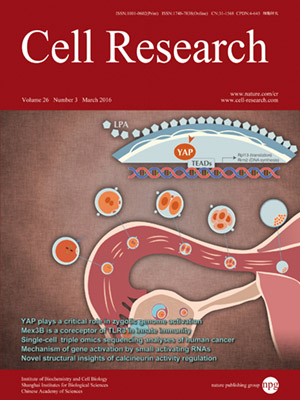
Volume 26, No 3, Mar 2016
ISSN: 1001-0602
EISSN: 1748-7838 2018
impact factor 17.848*
(Clarivate Analytics, 2019)
Volume 26 Issue 3, March 2016: 304-319 | Open Access
ORIGINAL ARTICLES
Single-cell triple omics sequencing reveals genetic, epigenetic, and transcriptomic heterogeneity in hepatocellular carcinomas
Yu Hou1,*, Huahu Guo2,3,4,*, Chen Cao1, Xianlong Li1, Boqiang Hu1, Ping Zhu1,6, Xinglong Wu1,6, Lu Wen1, Fuchou Tang1,5,6,7, Yanyi Huang1,6,8 and Jirun Peng2,3,4
1Biodynamic Optical Imaging Center, College of Life Sciences, Peking University, Beijing 100871, China
2Department of Surgery, Beijing Shijitan Hospital, Capital Medical University, Beijing 100038, China
3Ninth School of Clinical Medicine, Peking University, Beijing 100038, China
4School of Oncology, Capital Medical University, Beijing 100038, China
5Ministry of Education Key Laboratory of Cell Proliferation and Differentiation, Peking University, Beijing 100871, China
6Peking-Tsinghua Center for Life Science, Beijing 100084, China
7Center for Molecular and Translational Medicine (CMTM), Beijing 100101, China
8College of Engineering, Peking University, Beijing 100871, China
Correspondence: Fuchou Tang, E-mail: tangfuchou@pku.edu.cn; Yanyi Huang, E-mail: yanyi@pku.edu.cn; Jirun Peng,(pengjr@medmail.com.cn)
Single-cell genome, DNA methylome, and transcriptome sequencing methods have been separately developed. However, to accurately analyze the mechanism by which transcriptome, genome and DNA methylome regulate each other, these omic methods need to be performed in the same single cell. Here we demonstrate a single-cell triple omics sequencing technique, scTrio-seq, that can be used to simultaneously analyze the genomic copy-number variations (CNVs), DNA methylome, and transcriptome of an individual mammalian cell. We show that large-scale CNVs cause proportional changes in RNA expression of genes within the gained or lost genomic regions, whereas these CNVs generally do not affect DNA methylation in these regions. Furthermore, we applied scTrio-seq to 25 single cancer cells derived from a human hepatocellular carcinoma tissue sample. We identified two subpopulations within these cells based on CNVs, DNA methylome, or transcriptome of individual cells. Our work offers a new avenue of dissecting the complex contribution of genomic and epigenomic heterogeneities to the transcriptomic heterogeneity within a population of cells.
10.1038/cr.2016.23
FULL TEXT | PDF
Browse 2591


